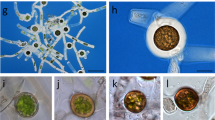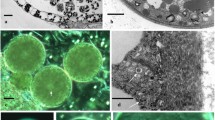Abstract
Different stages of megaspore and megasporangial development inSelaginella argentea (Wallich)Spring,S. bigelowiiUnerw., andS. kraussiana (Kze.)A. Br. have been seen and studied. Megaspore wall units give positive reactions for polysaccharides and protein in young megaspores, and become the thick and resistant wall typical of the genus only later.—Units forming the exospore and the spaces between units enlarge from widths of 5–10nm early during development up to over 200 nm at pregermination stages. The spaces enlarge first. Initially they are circular and mostly about 70 nm in diameter. Later, spaces toward the inner part of the exospore enlarge more than those near the outer surface. During pregermination, wall spaces range in size from 4 to 50 times the width of units with the larger spaces located near the inner surface. As a result the exospore would be under tension to spring outward during germination when the laesurae are lysed.—A gap in the exospore, shaped like a half-moon in polar sections, forms in equatorial and distal portions of the spore. This gap becomes enormous, three times the volume of the central space plus the mesospore, and is filled with lipids and other nutrients. Late in development, during the period of tapetal cell degeneration, the gap contents are moved into the central space and the gap is closed.—Late in development the mesospore is degraded. Its products, along with gap contents, seem to be added to the contents of the central cavity and appear as reserve storage globules. A primary wall-like endospore is formed during this period, at the inner surface of the exospore. During germination this endospore develops further at its inner surface.—Changes in the size and shape of megasporangia occur independently of the size of megaspores.
Similar content being viewed by others
References
Arnoldi, W., 1896: Die Entwicklung des weiblichen Vorkeims bei den heterosporen Lycopodiaceen. — Bot. Zeit.54: 159–168.
Bland, D. E., Foster, R. C., Logan, A. F., 1971: The mechanism of permanganate and osmium tetroxide fixation and the distribution of lignin in the cell walls ofRinus radiata. — Holzforschung25: 137–143.
Bruchmann, H., 1897: Untersuchungen überSelaginella spinulosaA. Br. — Gotha.
—, 1912: Zur Embryologie der Selaginellaceen. — Flora104: 180–224.
Buchen, B., Sievers, A., 1978a: Megasporogenese vonSelaginella. I. Ultrastrukturelle und cytochemische Untersuchungen zur Sekretion von Polysacchariden. — Protoplasma96: 293–317.
—, 1978b: Megasporogenese vonSelaginella. II. Ultrastrukturelle und cytochemische Untersuchungen zur Sekretion von Lipiden. — Protoplasma96: 319–328.
—, 1981: Sporogenesis and pollen grain formation. — InKiermayer, O., (Ed.): Cytomorphogenesis in plants, pp. 349–376. Cell Biology Monographs8. — New York, Wien: Springer.
Campbell, D. H., 1895: Structure and development of the mosses and ferns. — London: Macmillan.
—, 1902: Studies on the gametophyte ofSelaginella. — Ann. Bot. (London)16: 419–428.
Denke, P., 1902: Sporenentwicklung beiSelaginella. — Beih. Bot. Centralbl.12: 182–199.
Dumas, C., Charriere-Ladreix, Y., 1979: Étude cytochimique des polyphénols: généralités concernant les lignines et les sécrétions de tannins et d'aglycones flavoniques. — Bull. Soc. Bot. France, Lettres bot.2: 123–142.
Fitting, H., 1900: Bau und Entwicklungsgeschichte der Makrosporen vonIsoëtes undSelaginella und ihre Bedeutung für die Kenntnis des Wachstums pflanzlicher Zellmembranen. — Bot. Zeit.58: 107–165.
Foster, R. C., 1981: Polysaccharides in soil fabrics. — Science214: 665–667.
Gould, J. S., Vrba, E. S., 1982: Exaptation—a missing term in the science of form. — Paleobiology8: 4–15.
Graustein, J. E., 1930: Evidences of hybridism inSelaginella. — Bot. Gaz.90: 46–74.
Heinsen, E., 1894: Die Makrosporen und das weibliche Prothalium vonSelaginella. — Flora (Jena)78: 466–496.
Horner, H. T., Beltz, C. K., 1970: Cellular differentiation of heterospory inSelaginella. — Protoplasma71: 335–341.
Lugardon, B., 1971a: L'endospore et la “pseudo-endospore” des spores des Filicinées isosporées. — Compt. Rend. Acad. Sci. Paris273: 675–678.
—, 1971b: Contribution à la connaissance de la morphogénèse et da la structure des parois sporales chez les Filicinées isosporées. — Thèse Doct. Sci. Nat., Univ. P. Sabatier, Toulouse.
—, 1973: Sur les parois sporales dePsilotum triquetrumSw. et leur structure fine. — Compt. Rend. Acad. Sci. Paris276: 1277–1280.
—, 1978: Isospore and microspore walls of living pteridophytes: identification possibilities with different observation instruments. — IV Int. Palynol. Conf.,Lucknow1: 152–163.
—, 1986: Données ultrastructurales sur la fonction de l'exospore chez les Ptéridophytes. — InBlackmore, S., Ferguson, I. K., (Eds): Pollen and spores: form and function, pp. 252–264. — London: Academic Press.
Lyon, F. M., 1901: A study of the sporangia and gametophytes ofSelaginella apus andSelaginella rupestris. — Bot. Gaz.32: 124–170.
—, 1905: The spore coats ofSelaginella. — Bot. Gaz.40: 285–295.
Marinozzi, V., 1968: Phosphotungstic acid (PTA) as a stain for polysaccharides and glycoproteins in electron microscopy. — Proc. 4th European Regional Conference on EM, pp. 55–56. — Rome.
Mayo, M. A., Cocking, E. C., 1969: Pinocytotic uptake of polystyrene latex particles by isolated tomato fruit protoplasts. — Protoplasma68: 223–230.
Morbelli, M. A., 1992: Megaspore wall inLycophyta. Ultrastructure and function. — 8th Int. Palynol. Congress, p. 104 (Abstract). — Alix-en-Provence, France.
- 1994: Megaspore wall inLycophyta. Ultrastructure and function. — Rev. Palaeobot. Palynol. (in press).
-Rowley, J. R., 1992: Megaspore development inSelaginella. I. Wicks, their presence, ultrastructure and presumed function. — 8th Int. Palynol. Congress, p. 104 (Abstract). — Aix-en-Provence, France.
—, 1993: Megaspore development inSelaginella. I. “Wicks”, their presence, ultrastructure, and presumed function. — Sex. Pl. Reprod.6: 98–107.
Pettitt, J. M., 1966: Exine structure in some fossil and recent spores and pollen as revealed by light and electron microscopy. — Bull. Brit. Museum, Nat. Hist., Geol.13: 223–257.
—, 1971a: Developmental mechanisms in heterospory. I. Megasporocyte degeneration inSelaginella. — Bot. J. Linn. Soc.64: 237–246.
—, 1971b: Some ultrastructural aspects of sporoderm formation in pteridophytes. — InErdtman, G., Sorsa, P., (Eds): Pollen and spore morphology/plant taxonomy.Pteridophyta, pp. 227–251. — Stockholm: Almqvist & Wiksell.
—, 1976: A route for the passage of substances through the developing pteridophyte exine. — Protoplasma88: 117–131.
—, 1979a: Developmental mechanisms in heterospory: Cytochemical demonstration of spore-wall enzymes associated with β-lectins, polysaccharides and lipids in water ferns. — J. Cell Sci.38: 61–82.
—, 1979b: Ultrastructure and cytochemistry of spore wall morphogenesis. — InDyer, A. F., (Ed.): The experimental biology of ferns, pp. 213–252. — London: Academic Press.
Pfeffer, W. F. P., 1871: Die Entwicklung des Keimes der GattungSelaginella. — Hansteins Bot. Abhandl. Morph. Physiol.1: 1–80.
Pieniazek, S. A., 1938: Über die Entwicklung und das Wachstum der Makrosporen-Membranen beiSelaginella. — Compt. Rend. Soc. Sci. Varsovie31: 211–230.
Ramalingam, K., Ravinkranath, M. H., 1970: Histochemical significance of green metachromasia to toluidine blue. — Histochemie24: 322–327.
Rambourg, A., Hernandez, W., Leblond, C. P., 1969: Detection of complex carbohydrates in the Golgi apparatus of rat cells. — J. Cell Biol.40: 395–414.
Robert, D., 1971a: Le gametophyte femelle deSelaginella kraussiana (Kunze)A. Br. I. Organization generale de la megaspore. Le diaphragme et l'endospore. Les reserves. — Rev. Cytol. Biol. Veg.34: 93–164.
—, 1971b: Le gametophyte femelle deSelaginella kraussianaKunze (A. Br.). II. Organisation histologique du tissu reproducteur et principaux aspects de la dedifferenciation cellulaire preparatoire a l'oogenese. — Rev. Cytol. Biol. Veg.34: 189–232.
—, 1972a: Le gametophyte femelle deSelaginella denticulata (L.)Spring. — Rev. Cytol. Biol. Veg.35: 243–280.
—, 1972b: Quelques particularites de la reproduction chez les Selaginelles. — Bull. Soc. Bot. France119: 373–382.
Roland, J.-C., Lembi, C. A., Morre, J., 1972: Phosphotungstic acid-chromic acid selective electron-dense stain for plasma membranes of plant cells. — Stain Technol.47: 195–200.
Rowley, J. R., 1994: Exine origin, development, and structure in pteridophytes, gymnosperms, and angiosperms. — InJansonius, J., McGregor, D. C., (Eds): Palynology: principles and applications, chapter 14D. — American Association of Stratigraphic Palynologists Foundation,1. (In press.)
—, 1992: Lipid in wall and cytoplasm ofSolidago pollen. — Grana31: 273–283.
-Morbelli, M. A., 1993: Megaspore development inSelaginella. The gap, its location and presumed function. — 15th Int. Bot. Congr., Japan, Abstr., p. 432.
Sievers, A., Buchen, B., 1970: Über den Feinbau der wachsenden Megaspore vonSelaginella. — Protoplasma71: 267–279.
—, 1971: Contact between the spore cytoplasm and the growing sporoderm of theSelaginella megaspore. — InBrooks, J., Grant, P. R., Muir, M., Van Gijzel, P., Shaw, G., (Eds): Sporopollenin, pp. 654–658. — London: Academic Press.
Smith, M. M., McCully, M. E., 1978: A critical evaluation of the specificity of aniline blue induced fluorescence. — Protoplasma95: 229–254.
Spurr, A. R., 1969: A low-viscosity epoxy resin embedding medium for electron microscopy. — J. Ultrastruct. Res.266: 31–43.
Stainier, F., 1965: Structure et infrastructure des parois sporales chez deux Selaginelles (Selaginella myosurus etS. kraussiana). — La Cellule65: 221–344.
Stempak, J. G., Ward, R. T., 1964: An improved staining method for electron microscopy. — J. Cell Biol.22: 697–701.
Taylor, W. A., 1991: Ultrastructural analysis of sporoderm development in megaspores ofSelaginella galeottii (Lycophyta). — Pl. Syst. Evol.174: 171–182.
—, 1994: Recognition and characterization of inner exospore wall layers in modern and fossil lycopsids—the mesospore. — Grana33: 44–48.
Thiéry, J. P., 1967: Mise en évidence des polysaccharides sur coupes fines en microscopie électronique. — J. Microscopie69: 987–1018.
Tryon, A. F., Lugardon, B., 1991: Spores of thePteridophyta. — Berlin, New York: Springer.
Author information
Authors and Affiliations
Additional information
Megaspore development inSelaginella. II. For first part seeMorbelli & Rowley (1993).
Rights and permissions
About this article
Cite this article
Rowley, J.R., Morbelli, M.A. Megaspore wall growth in Selaginella (Lycopodiatae). Pl Syst Evol 194, 133–162 (1995). https://doi.org/10.1007/BF00982852
Received:
Revised:
Accepted:
Published:
Issue Date:
DOI: https://doi.org/10.1007/BF00982852




